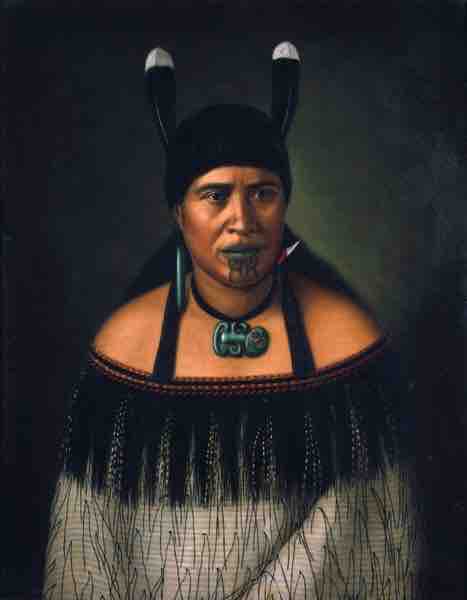Overview: New Zealand
New Zealand is an island country in the southwestern Pacific Ocean. The country geographically comprises two main landmasses—that of the North and South Islands—and numerous smaller islands. Because of its remoteness, it was one of the last lands to be settled by humans. Polynesians settled New Zealand in 1250–1300 CE and developed a distinctive Māori culture, and Europeans first made contact in 1642 CE. The British and Irish immigrants brought aspects of their own culture to New Zealand and heavily influenced Māori culture, particularly with the introduction of Christianity. More recently, American, Australian, Asian, and other European cultures have exerted influence on New Zealand.
New Zealand art includes traditional Māori art, which was developed in New Zealand from Polynesian art forms, and more recent forms which take their inspiration from Māori, European, and other traditions.
Early Charcoal Drawings
Charcoal drawings can be found on limestone rock shelters in the center of the South Island, with over 500 sites stretching from Kaikoura to North Otago. The drawings are estimated to be between 500 and 800 years old and portray animals, people, and fantastic creatures. Some of the birds pictured are long extinct and were drawn by early Māori; however by the time Europeans arrived, local inhabitants did not know the origins of the drawings.
Traditional Māori art
Māori visual art consists primarily of four forms: carving, tattooing (ta moko), weaving, and painting. Traditional Māori art was highly spiritual and conveyed information about ancestry and other culturally important topics. Most traditional Māori art was highly stylized and featured motifs such as the spiral, the chevron, and the koru. The colors black, white, and red dominated.

Portrait of Hinepare of Ngāti Kahungunu by Gottfried Lindauer, showing chin moko, pounamu hei-tiki, and woven cloak
This portrait shows traditional jewelry (known as hei-tiki), woven cloth, and chin moko, or tattooing.
Carving
Carving was done in wood, bone, and stone. Wood carvings were used to decorate houses, fencepoles, containers, and other objects. Both stone and bone were used to create jewelry such as the hei-tiki. The introduction of metal tools by Europeans allowed more intricacy and delicacy, causing stone and bone fish hooks and other tools to become purely decorative.
Māori carving
Late 20th century carved house post depicting the navigator Kupe. Although in an essentially traditional style, this carving was created using metal tools and uses modern paints, creating a form distinct from that of pre-European times.
Ta moko
Ta moko is the art of traditional Māori tattooing, done with a chisel. Men were tattooed on many parts of their bodies, including faces, buttocks, and thighs. Women were usually tattooed only on the lips and chin. Moko conveyed a person's ancestry. The art declined in the 19th century following the introduction of Christianity, but in recent decades it has undergone a revival.
Weaving
Weaving was used to create numerous things, including wall panels in meeting houses and other important buildings, as well as clothing and bags (known as kete). While many of these were purely functional, others were true works of art, taking hundreds of hours to complete and often given as gifts to important people. In pre-European times, the main medium for weaving was flax; however, following the arrival of Europeans, cotton, wool, and other textiles were also used.
Painting
In 'classical' Māori art, painting was not an important art form. It was mainly used as a minor decoration in meeting houses, in stylized forms such as the koru. Europeans introduced Māori to their more figurative style of art, and in the 19th century, less stylized depictions of people and plants began to appear in place of traditional carvings and woven panels.